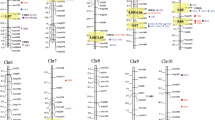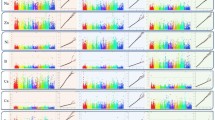Abstract
Trace metal elements are essential in daily diets for human health and normal growth. Maize is staple food for people in many countries. However, maize has low mineral concentration which makes it difficult to meet human requirements for micronutrients. The objective of this study was to identify quantitative trait locus (QTL) and predict candidate genes associated with mineral concentration in maize grain. Here, a recombinant inbred line population was used to test phenotype of zinc (Zn), iron (Fe), copper (Cu) and manganese (Mn) concentrations in six environments and then a QTL analysis was conducted using single environment analysis along with multiple environment trial (MET) analysis. These two strategies detected a total of 64 and 67 QTLs for target traits, respectively. Single environment analysis revealed 13 QTL bins distributed on seven chromosomes. We found that five candidate genes associated with mineral concentration were located in the same intervals identified by Comparative mapping of meta-QTLs in our previous study. The genetic and phenotypic correlation coefficients were depended on the nutrient traits and they were significant between Fe and Zn, Fe and Cu, Fe and Mn in all environments. The results of this study illustrated the genetic correlation between maize grain mineral concentrations, and identified some promising genomic regions and candidate genes for further studies on the biofortification of mineral concentration in maize grain.


Similar content being viewed by others
Change history
15 March 2018
By mistake this article had a note indicating that the article is part of the following topical collection: “This article is part of the Topical Collection on Plant Breeding: the Art of Bringing Science to Life. Highlights of the 20th EUCARPIA General Congress, Zurich, Switzerland, 29 August–1 September 2016 Edited by Roland Kölliker, Richard G. F. Visser, Achim Walter & Beat Boller” The article however is not part of this collection and should be seen as such by the reader.
References
Akimasa S, Naoki Y, Jixing X, Jian Feng M (2011) OsYSL6 is involved in the detoxification of excess manganese in rice. Plant Physiol 157(4):1832–1840
Anuradha K, Agarwal S, Rao YV, Rao K, Viraktamath B, Sarla N (2012) Mapping QTLs and candidate genes for iron and zinc concentrations in unpolished rice of Madhukar × Swarna RILs. Gene 508(2):233–240
Benke A, Stich B, Donini P (2011) An analysis of selection on candidate genes for regulation, mobilization, uptake, and transport of iron in maize. Genome 54(8):674–683
Blair MW, Astudillo C, Grusak MA, Graham R, Beebe SE (2009) Inheritance of seed iron and zinc concentrations in common bean (Phaseolus vulgaris L.). Mol Breeding 23(2):197–207
Chakraborti M, Prasanna BM, Hossain F, Mazumdar S, Singh AM, Guleria S, Gupta HS (2011) Identification of kernel iron- and zinc-rich maize inbreds and analysis of genetic diversity using microsatellite markers. J Plant Biochem Biotechnol 20(2):224–233
Chomba E, Westcott CM, Westcott JE, Mpabalwani EM, Krebs NF, Patinkin ZW, Palacios N, Hambidge KM (2015) Zinc absorption from biofortified maize meets the requirements of young rural Zambian children. J Nutr 114:204933
Gao X, Huang Y, Chen J (2008) Combining ability analysis of Zn and Fe content in maize seed. J Plant Genet Resour 9(1):36–40
Garcia-Oliveira AL, Tan L, Fu Y, Sun C (2009) Genetic identification of quantitative trait loci for contents of mineral nutrients in rice grain. J Integr Plant Biol 51(1):84–92
Gibson RS (2006) Zinc: the missing link in combating micronutrient malnutrition in developing countries. Proc Nutr Soc 65(01):51–60
Holland JB (2006) Estimating genotypic correlations and their standard errors using multivariaterestricted maximum likelihood estimation with SAS Proc MIXED. Crop Sci 46:642–656
Ishimaru Y, Bashir K, Nishizawa NK (2011) Zn uptake and translocation in rice plants. Rice 4(1):21–27
Ishimaru Y, Takahashi R, Bashir K, Shimo H, Senoura T, Sugimoto K, Ono K, Yano M, Ishikawa S, Arao T, Nakanishi H, Nishizawa NK (2012) Characterizing the role of rice NRAMP5 in manganese, iron and cadmium transport. Sci Rep 2:286
Jin T, Zhou J, Chen J, Zhu L, Zhao Y, Huang Y (2013) The genetic architecture of zinc and iron content in maize grains as revealed by QTL mapping and meta-analysis. Breed Sci 63(3):317–324
Jin T, Chen J, Zhu L, Zhao Y, Guo J, Huang Y (2015) Comparative mapping combined with homology-based cloning of the rice genome reveals candidate genes for grain zinc and iron concentration in maize. BMC Genet 16:17
Kennedy G, Nantel G, Shetty P (2003) The scourge of” hidden hunger”: global dimensions of micronutrient deficiencies. Food Nutr Agric 32:8–16
Kosambi D (1943) The estimation of map distances from recombination values. Ann Eugen 12(1):172–175
Lee S, Kim SA, Lee J, Guerinot ML, An G (2010) Zinc deficiency-inducible OsZIP8 encodes a plasma membrane-localized zinc transporter in rice. Mol Cells 29(6):551–558
Li S, Zhou X, Huang Y, Zhu L, Zhang S, Zhao Y, Guo J, Chen J, Chen R (2013) Identification and characterization of thezinc-regulated transporters, iron-regulatedtransporter-like protein (ZIP) gene familyin maize. BMC Plant Biol 13(114):114
Liu Z, Wang H, Wang X, Zhang G, Chen P, Liu D (2006) Genotypic and spike positional difference in grain phytase activity, phytate, inorganic phosphorus, iron, and zinc contents in wheat (Triticum aestivum L.). J Cereal Sci 44(2):212–219
López-Millán AF, Ellis DR, Grusak MA (2004) Identification and characterization of several new members of the ZIP family of metal ion in Medicago truncatula. Plant Mol Biol 54(4):583–596
Lung’aho MG, Mwaniki AM, Szalma SJ, Hart JJ, Rutzke MA, Kochian LV, Glahn RP, Hoekenga OA (2011) Genetic and physiological analysis of iron biofortification in maize kernels. PLoS ONE 6(6):e20429
Maret W, Sandstead HH (2006) Zinc requirements and the risks and benefits of zinc supplementation. J Trace Elem Med Biol 20(1):3–18
Menguer PK, Farthing E, Peaston KA, Ricachenevsky FK, Fett JP, Williams LE (2013) Functional analysis of the rice vacuolar zinc transporter OsMTP1. J Exp Bot 64(10):2871–2883
Oikeh SO, Menkir A, Maziya-Dixon B, Welch R, Glahn RP (2007) Genotypic differences in concentration and bioavailability of kernel-iron in tropical maize varieties grown under field conditions. J Plant Nutr 26(10):2307–2319
Peleg Z, Cakmak I, Ozturk L, Yazici A, Jun Y, Budak H, Korol AB, Fahima T, Saranga Y (2009) Quantitative trait loci conferring grain mineral nutrient concentrations in durum wheat × wild emmer wheat RIL population. Theor Appl Genet 119(2):353–369
Peng B, Li Y, Wang Y, Liu C, Liu Z, Tan W, Zhang Y, Wang D, Shi Y, Sun B (2011) QTL analysis for yield components and kernel-related traits in maize across multi-environments. Theor Appl Genet 122(7):1305–1320
Qin H, Cai Y, Liu Z, Wang G, Wang J, Guo Y, Wang H (2012) Identification of QTL for zinc and iron concentration in maize kernel and cob. Euphytica 187(3):345–358
Saghai-Maroof M, Soliman K, Jorgensen RA, Allard R (1984) Ribosomal DNA spacer-length polymorphisms in barley: Mendelian inheritance, chromosomal location, and population dynamics. Proc Natl Acad Sci 81(24):8014–8018
Shintaro K, Haruhiko I, Daichi M, Michiko T, Hiromi N, Satoshi M, Nishizawa NK (2004) OsYSL2 is a rice metal-nicotianamine transporter that is regulated by iron and expressed in the phloem. Plant J 39(3):415–424
Šimić D, Drinić SM, Zdunić Z, Jambrović A, Ledenčan T, Brkić J, Brkić A, Brkić I (2012) Quantitative trait loci for biofortification traits in maize grain. J Hered 103(1):47–54
Sperotto RA, Boff T, Duarte GL, Santos LS, Grusak MA, Fett JP (2010) Identification of putative target genes to manipulate Fe and Zn concentrations in rice grains. J Plant Physiol 167(17):1500–1506
Srinivasa J, Arun B, Mishra VK, Singh GP, Velu G, Babu R, Vasistha NK, Joshi AK (2014) Zinc and iron concentration QTL mapped in a Triticum spelta × T. aestivum cross. Theor Appl Genet 127(7):1643–1651
Stein AJ (2010) Global impacts of human mineral malnutrition. Plant Soil 335(1–2):133–154
Tiwari VK, Rawat N, Chhuneja P, Neelam K, Aggarwal R, Randhawa GS, Dhaliwal HS, Keller B, Singh K (2009) Mapping of quantitative trait loci for grain iron and zinc concentration in diploid A genome wheat. J Hered esp030
Van Ooijen J (2006) JoinMap 4. Software for the calculation of genetic linkage maps in experimental populations Kyazma BV, Wageningen, Netherlands
Velu G, Ortiz-Monasterio I, Cakmak I, Hao Y, Singh RP (2014) Biofortification strategies to increase grain zinc and iron concentrations in wheat. J Cereal Sci 59(3):365–372
Vert G, Grotz N, Dédaldéchamp F, Gaymard F, Guerinot ML, Briat J-F, Curie C (2002) IRT1, an Arabidopsis transporter essential for iron uptake from the soil and for plant growth. Plant Cell Online 14(6):1223–1233
Wan X, Wan J, Jiang L, Wang J, Zhai H, Weng J, Wang H, Lei C, Wang J, Zhang X (2006) QTL analysis for rice grain length and fine mapping of an identified QTL with stable and major effects. Theor Appl Genet 112(7):1258–1270
Wang J, Li H, Zhang L, Li C, Meng L (2013) Users’ Manual of QTL IciMapping. The Quantitative Genetics Group, Institute of Crop Science, Chinese Academy of Agricultural Sciences (CAAS), Beijing 100081, China, and Genetic Resources Program, International Maize and Wheat Improvement Center (CIMMYT), Apdo Postal 6-641, 06600 Mexico, DF, Mexico 100081
Waters BM, Grusak MA (2008) Quantitative trait locus mapping for seed mineral concentrations in two Arabidopsis thaliana recombinant inbred populations. New Phytol 179(4):1033–1047
Welch RM, Graham RD (2002) Breeding crops for enhanced micronutrient content. Plant Soil 245(1):205–214
Welch RM, Graham RD (2004) Breeding for micronutrients in staple food crops from a human nutrition perspective. J Exp Bot 55(396):353–364
Yang X, Huang J, Jiang Y, Zhang HS (2009) Cloning and functional identification of two members of the ZIP (Zrt, Irt-like protein) gene family in rice (Oryza sativa L.). Mol Biol Rep 36(2):281–287. doi:10.1007/s11033-007-9177-0
Yang G, Dong Y, Li Y, Wang Q, Shi Q, Zhou Q (2013) Verification of QTL for grain starch content and its genetic correlation with oil content using two connected RIL populations in high-oil maize. PLoS ONE 8(1):e53770
Yuan L, Yang S, Liu B, Zhang M, Wu K (2012) Molecular characterization of a rice metal tolerance protein, OsMTP1. Plant Cell Rep 31(1):67–79
Zdunić Z, Grljušić S, Ledenčan T, Duvnjak T, Šimić D (2014) Quantitative trait loci mapping of metal concentrations in leaves of the maize IBM population. Hereditas 151(2–3):55–60
Acknowledgements
This work was supported by a Grant from the Hebei Province Science and Technology Support Program, China (16226323D-2, 14226305D-5).
Author information
Authors and Affiliations
Corresponding author
Ethics declarations
Conflict of interest
The authors declare that they have no conflict of interest.
Additional information
Huaduo Zhang and Jingxian Liu have contributed equally to the work.
A correction to this article is available online at https://doi.org/10.1007/s10681-018-2143-1.
Rights and permissions
About this article
Cite this article
Zhang, H., Liu, J., Jin, T. et al. Identification of quantitative trait locus and prediction of candidate genes for grain mineral concentration in maize across multiple environments. Euphytica 213, 90 (2017). https://doi.org/10.1007/s10681-017-1875-7
Received:
Accepted:
Published:
DOI: https://doi.org/10.1007/s10681-017-1875-7




